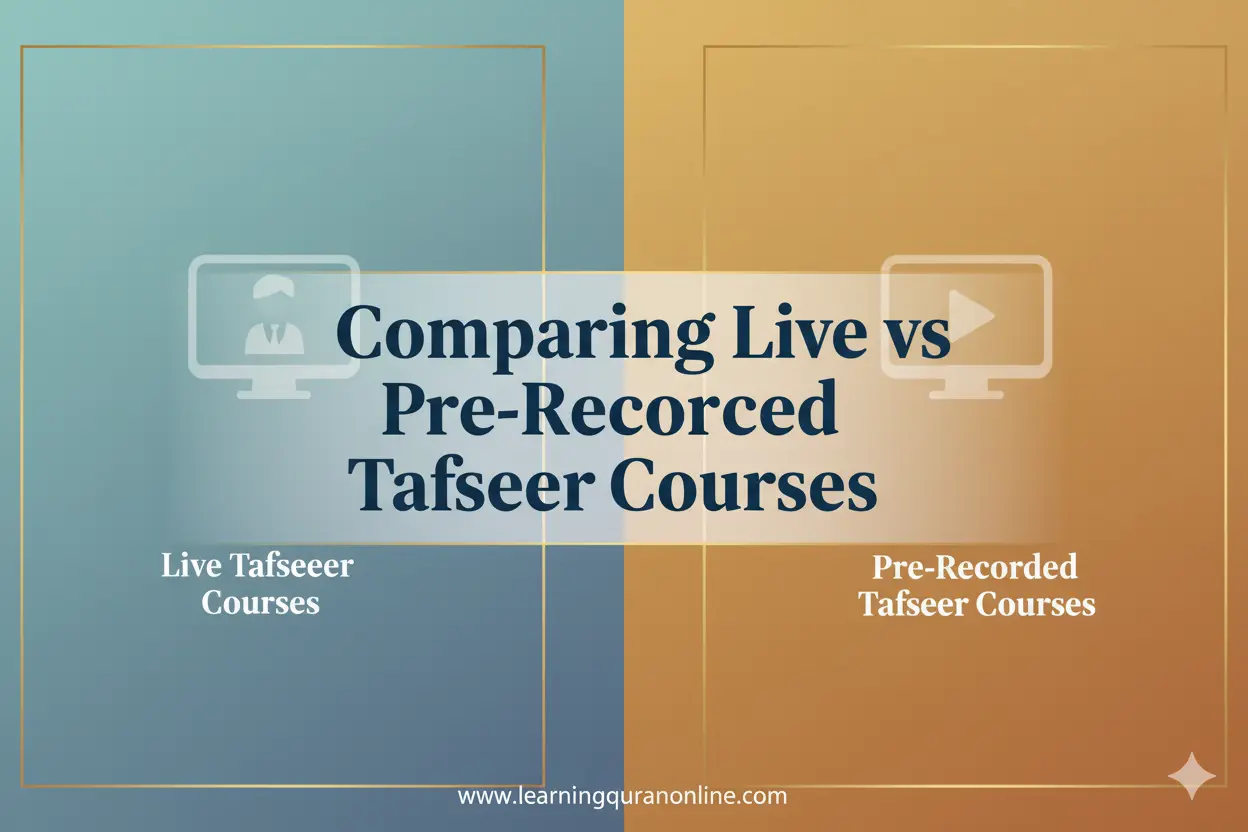Color-coded Quran online resources are revolutionizing how students tackle Quran recitation, Arabic pronunciation, and memorization. They offer visual cues, verse-by-verse audio, translations and transliteration, and more to help learners of all levels. This guide explores the benefits of color-coded Qurans, key factors to consider when choosing an online resource, and tips for getting the most out of them for recitation, fluency, and comprehension improvement.
A color-coded Quran is a Mushaf – a Quranic text or digital platform – in which tajweed rules and pronunciation patterns are displayed in a variety of colors. Each color corresponds to a particular tajweed rule, such as elongation, nasalization, silent letters, or unique stopping signs. This makes Arabic phonetics and rules, or tajweed, immediately obvious and evident. Online platforms and tajweed apps offer interactive colors that illuminate and make audible the rule when clicked on.
Table of Contents
ToggleWhy Color-Coded Tajweed Is Critical to Online Quran Learning
Citing the Arabic script, structural tajweed marks, and mandatory qa’ida tajweed rules can be demanding for so many students. Color-coded Qurans simplify this by establishing visualities related to tajweed patterns and rules: characteristics comprise the following:
- Increased rule identification: Color aids in rapidly identifying rules like idgham, Iqlab, and Ikhfa and understanding them without including decode the diacritics.
- Pronunciation skill development: color with sound allows pupils to learn the appropriate mouth gestures to develop a recitation rhythm.
- Better Hifz: memory patterns act as oracle tips during repetition and recall.
- Beginner-friendly: elementary and middle school-aged pupils and second-language speakers can begin with confidence using transliteration and color.
- Practice consistency and feedback: voice comparison and talaffuz Quran practice with pronunciation assessment.
Key Features to Search for in a Color-Coded Quraninary Platform:
When choosing an online or mobile Quran platform, the goal is to engage with features oriented toward learning, mobile studying, and long-term retention. Some good ones include the following:
- Accurate color-coded tajweed system: each platform should have a clear legend and color that does not alternate between tajweed rules. Ideally, one color should signal the same rule in all pages.
- High-quality audio: the reader should recite a verse at a time, and multiple Qaris should perform if possible. It helps to channel the reader to pronunciation and recite timing.
- Interactive tools: clickable words to play or hear pronunciation, slow play, loop play for ayahs that are hard to pronounce, and transliterate to pronunciation and repeat for difficulty.
- Translation & Tafsir: simple translations in many languages and brief tafsir of the verse with sources.
- Search & bookmarks: one should be able to search for a surah, memorize ayahs, and bookmark, given a choice.
- Lesson plans and courses: Tajweed lessons, Noorani Qaida type introduction, Recitation schedule, and planner.
- Offline: teach offline with downloadable mushaf pages and audio.
Types of Color-Coded Quran Online Resources Include the Following:
- Get started with the legend: See all colors – madd, ghunnah, qalqalah, idgham etc. – and understand what they represent. Your legend is your reference map.
- Listen & Repeat: Watch a skilled reciter do each ayah, then repeat them – word by word by word. Follow the color codes to ensure you’re nailing the pronunciation.
- Slow playback & looping: Slow down the audio on particularly difficult sections or sentences. Loop on a particular phrase or group of words until the pronunciation is second nature.
- Use transliteration intelligently: Transliteration can help beginners, but at some point, you are going to have to learn to read Arabic script. If your Tajweed program uses color-coded Tajweed signs and you are an Arabic learner, it’s best to start early.
- Use a ma‘idh: These may be basic or advanced, but your ma‘idh will let you know if you’re getting things wrong.
- Use a Yellow brick road: Practice with a teacher: Find someone qualified in the science of tajweed to listen for your errors, however slight, and correct you. Then use your benchmark.
- Follow Hifz and revision: Bookmark these and set a routine for revisions. After some time, you will notice how many come easily to your mind – or not.
How to Choose the Right System of Color Coding Tajweed
Different systems use different color schemes. How to find the right one:
- Search for standards: some adhere to more widely accepted tajweed conventions. Others may still work, but they need to include a tutorial.
- Find a demo: Yes, the colors and the audio have to work for you. Try it out – you don’t have to buy. Look for the video that accompanies your colors.
- Look for pedagogical support: that means demonstrations and student practice, including ma‘idh.
- Read reviews: Find out how well it works from actual students.
Top Use Cases: Who Benefits Most from Color-Coded Quran Resources?
- Children: It’s a simplified, visual learning task, with bright colors and fun instructions.
- Non-Arabic speakers: Together with office hours, transliteration combined accelerates the Arabic phonetics lesson.
- New Muslims: Aling from beginning to end, from mess to the clean-room, the circuitous bits to a happy end in pronunciation confidence.
- Advanced students: Get advanced training in the classical art of recitative memorizing and compare the subtle differences of tunes.
- Hifz students: Use the ‘road’ to memorize another set of words each day.
Practical Tips and Best Practices
The following best practices will help you capitalize on any color-coded Quran online resource:
- Consistency: Short daily sessions, matching a 15–30 minute/day, are better than long sessions whenever you have some free time.
- Audio-Visual Synchronization: Reading while listening to the reciter and responding to the color signal.
- Record and compare: a voice recorder and comparison with the model reciter will present your errors.
- Minimal Tafsir: short motivational notes after reciting a passage; reading to understand means encourage practice.
- Qualified Feedback: Subtle mistakes that automated tools cannot detect in forum discussions or teachers.
FAQs
- Are color-coded Qurans clone-bashed? Yes—color-coding is a pedagogical articulated overlay. The Arabic text remains the same, and only colors the tajweed rules. You apply a color-coded Quran that uses the authentic Uthmani script and reputable editorial standards.
- Will color-coding make me a signal color addict? Coloration is akin to the training wheels on a bike – they aid a learner in his quest, and then they go away. At first, the remaining color helps one learn; afterward, the new learner memorizes one-use-tajweed rules in uncolored texts and gets used to it.
- Can I Hifz using color-coded guidelines? Many Hifz students use it and report faster amortization due to the use of colors as visual anchors. Deplete it with repetition in combination with audio, spaced, and educated repetition.
Conclusion
Color-coded Quran online resources are robust tools for any serious learner of tajweed, a Quran for students, and repeated memorization. It weaves visual learning and auditory mastery and universal accessible tajweed rules for everyone. Choose a reader with appropriate color-mapping, clear sound, tinted lessons, and tutoring. With continuous drill, automated feedback, and the most capable electronic mashaf, learners of all ages and levels can enrich their Quranic exercise and connection with the Quran.
Visit Our Online Quran Academy – LQO Learning Quran Online
The COVID-19 crisis inspired a major shift in the way Quran students interact with Arabic written texts. With some perseverance, the new, zoomed-in habit will help you to master their recitation. What should you do now? Find reputable digital mushafs, try out a few color-coded tools, and develop a daily practice; your recitation skills will only get better the more time and energy you put into them.
















